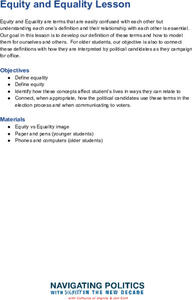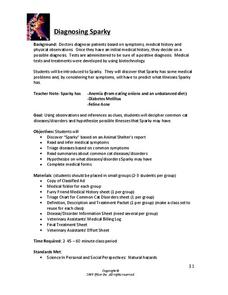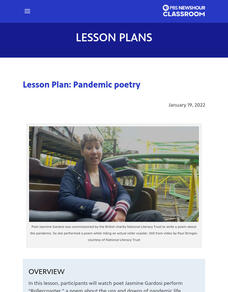Nebraska Department of Education
Stress and Coping
Life can be stressful. Class members fill out T-charts identifying stressors associated with school, parents, friends, and life then list coping strategies that can help with each category.
Nebraska Department of Education
This I Believe
As part of a Career Develop unit, eighth-graders reflect on their beliefs and values and consider how these beliefs might affect their relationships with friends and with colleagues when they join the workforce.
Nebraska Department of Education
Time Management
As eighth-graders move on to high school, strong time management skills become critical. As part of a career Planning & Management unit, scholars learn how to analyze their time and consider how their choices impact their ability to...
Nebraska Department of Education
Who Am I?
When people look in a mirror, they rarely see themselves as others see them. Tweens and teens can consider the significance of these disparities in a lesson that asks them to reflect on the kind of person they are and how they think...
National Institute of Drug Abuse
Nurturing My Mental and Emotional Health
One exercise does not necessarily work for all! A resource from the National Institutes of Health provides tweens and teens with exercises to help them cope with anxiety and stress. Participants note their stress levels before and after...
Newseum
You Can’t Say That: Right to Know vs. Security Risk
Print or block? That is the question young journalists debate as part of their study of the freedom of the press. Half the class represents the journalists' legal team, and the other half represents the government's legal team. Teams...
Scholastic
Stressed Out?
Provide tweens and teens with information they need to know about stress with an article that details how stress affects various organs in the body. The article also offers tips for healthy ways to cope with stress.
Canadian Mental Health Association
Busting Stress: Stress Management Lesson Plans
Feeling stressed? Who are you going to call? Why stress busters, of course! A 15-page booklet includes activities designed for tweens and teens. Participants first take a stress test to determine their level of stress. They then learn...
Cultures of Dignity
Equity and Equality Lesson
Equality does not equal equity and this lesson explains why. Class members compare two images--one labeled "Equality" and the other "Equity." Using the provided discussion questions, they then develop definitions that distinguish between...
Beyond Benign
Lucky Brand Genes: Genetic Traits
Explore single-gene traits in humans. After viewing a video introducing genetic vocabulary, individuals identify their phenotype and possible genotypes of specific traits. They consider both dominant and recessive traits. This is the...
Beyond Benign
Diagnosing Sparky
Be a vet for a day! Scholars test their veterinarian skills by assessing symptoms and making a diagnosis. They then evaluate biotechnology tests to verify the diagnosis.
Beyond Benign
Urine Jeopardy
Urine can tell us a lot about what is happening in our bodies. In a hands-on activity, scholars administer pH, glucose, ketone, and protein tests to a sample of "urine" solution made from household ingredients. Their results lead them to...
University of Maine
Don’t Fall Into the Thinking Trap
The final activity in a three-part healthy living series has class members examine five thinking traps that distort how they perceive themselves and/or situations. They also learn strategies that help stop the downward spiral and get...
University of Maine
Stress Less — Teen Stress Management
The second lesson plan in the Healthy Living series looks at stress management and provides teens with tools and coping strategies.
University of Maine
Healthy Relationships
A three-part Healthy Living Curriculum begins with a look at how self-esteem impacts relationships. Individuals identify their own positive qualities and then consider how statements on social media may impact self-esteem.
Amani Project
Write a CoronaKindness Song
And the beat goes on! Finding a way to connect during the isolation imposed by the Coronavirus pandemic can be challenging. This activity from the Amani Project offers a way to stay close during a time of physical distancing....
Amani Project
Harmony Break! Finding Emotions With Music
Gather the entire family (or class members) for a fun Harmony Break! A volunteer thinks of a color from their Mood Meter that they will express by singing, playing an instrument, or performing a dance. After the performance, the audience...
Amani Project
Harmony Break! Mood Shifting
The fifth activity in the Amani Project series, another Harmony Break, has participants demonstrate a mood shift. They begin by drumming in a way that indicates their current feelings. They then model a change in mood by transitioning...
Amani Project
Teach the Mood Meter
The third activity from the Amani Project has youths create a Mood Meter. The colorful meter, divided into red, yellow, blue, and green squares, lets participants indicate not only how they are feeling but also permits them to indicate...
Amani Project
The 5 Elements of Music
A series of activities teach young musicians that they don't need a room full of instruments to make music. The second activity in the Amani Project has participants use their hands, feet, and voices to demonstrate the five elements of...
Amani Project
Make an Instrument
Create a little harmony with Amani Project! Young musicians create their instruments using found or recycled objects. As an introduction, class members first experiment with sounds they can make with their bodies (clapping, stomping...
ReadWriteThink
Robert Frost Prompts the Poet in You
A great poem begins with an idea, an image, or an event that evokes a feeling. Middle schoolers read biographical information about Robert Frost and then identify details in three of his poems that reflect his life. Using suggestions...
ReadWriteThink
What is Poetry? Contrasting Poetry and Prose
Introduce middle schoolers to the different strategies used when reading prose versus poetry. Groups use a Venn diagram and a poetry analysis handout to compare the characteristics of an informational text and a poem on the same...























